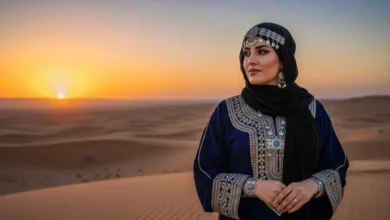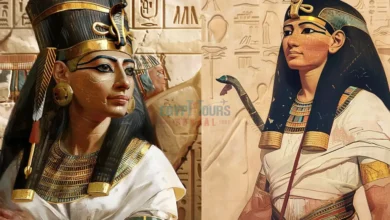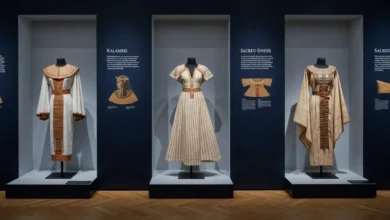Discover the hidden meanings behind the colors in ancient Egyptian clothing. Learn why white symbolized purity, gold represented the gods, and green was the color of resurrection.
A Journey Through Meaning
In ancient Egypt, color was not merely a matter of aesthetics; it was a language of its own. Every shade, from the pristine white of a priest’s robe to the vibrant blue of a queen’s collar, was imbued with deep symbolic meaning. These colors were a visual representation of the Egyptians’ beliefs about life, death, divinity, and the natural world.
The choice of color in a garment was a deliberate act, a way to communicate status, power, and spiritual connection. It was a visual prayer, a protective amulet, and a declaration of identity all woven into one.
In this guide, we will decode the ancient Egyptian color palette and explore the profound symbolism behind each hue. You will learn:
✅ The meaning of the primary colors: white, black, red, yellow, blue, and green.
✅ How these colors were sourced from the natural world.
✅ The role of color in defining social status and religious roles.
✅ How the symbolism of these colors continues to influence art and fashion today.
 👗 A Woman’s Wardrobe Through Time: The Evolution of Traditional Women’s Clothing in Egypt
👗 A Woman’s Wardrobe Through Time: The Evolution of Traditional Women’s Clothing in EgyptPrepare to see the world of ancient Egyptian fashion not just in terms of style, but in a full spectrum of meaning.
⚪ White (Hedj): The Color of Purity and Sanctity
White was the most common and fundamental color in ancient Egyptian clothing. It was the natural color of undyed linen, the primary textile of the time, making it accessible to all social classes. But its ubiquity did not diminish its power.
Symbolism:
- Purity and Cleanliness: White was synonymous with purity, both physical and spiritual. It was the color of cleanliness and simplicity, essential in a hot desert climate.
- Sanctity and Ritual: Priests and priestesses wore only white linen robes during religious ceremonies to signify their ritual purity. The sacred animals dedicated to the gods were also often depicted as white.
- Joy and Celebration: While it was an everyday color, white was also the color of festive occasions, representing light and celebration.
Source:
See also Ancient Egyptian Clothing: Shendyt, Kalasiris and Symbolic Accessories
Ancient Egyptian Clothing: Shendyt, Kalasiris and Symbolic Accessories- Primarily from undyed linen (flax). The whiter the linen, the finer its quality and the higher the status of the wearer.
In Context: The simple white kilt (shendyt) worn by a farmer and the elaborate, pleated white gown of a noblewoman both shared the same fundamental symbolism of purity, though their quality and style denoted their different social standings.
⚫ Black (Kem): The Color of the Underworld and Regeneration
Black was a color of powerful duality. While often associated with death and the underworld, it was not a color of mourning or evil. Instead, it was linked to the life-giving properties of the Nile.
Symbolism:
- The Underworld and the Night: Black was the color of the night and the realm of Osiris, the god of the underworld and resurrection. It represented the darkness of the tomb, from which new life could emerge.
- Fertility and Regeneration: The name for Egypt itself was Kemet, meaning “the Black Land,” a reference to the rich, fertile black silt deposited by the annual flooding of the Nile. Thus, black was a symbol of fertility, new life, and the promise of resurrection.
- Protection: Black kohl, used to line the eyes, was not just cosmetic. It was believed to have magical protective properties, warding off the “evil eye” and protecting against eye infections from the sun’s glare and flies.
Source:
- Charcoal and soot for pigments and dyes.
- Galena (a lead sulfide mineral) for black kohl eyeliner.
In Context: A pharaoh might be depicted with black skin not to represent his ethnicity, but to identify him with Osiris and to symbolize his power of regeneration and eternal life.
🔴 Red (Desher): The Color of Life, Power, and Danger
Red was another color of potent duality, representing both the vibrant energy of life and the destructive force of chaos.
Symbolism:
- Life, Vigor, and Energy: Red was the color of blood and fire. It symbolized life, health, and vitality. Red amulets, such as the Tyet (Knot of Isis), were worn to protect the wearer.
- Power and Victory: The pharaoh’s crown of Lower Egypt, the Deshret, was red. Warriors would paint their bodies with red ochre before battle to imbue themselves with strength.
- Danger and Chaos: Red was also linked to the desert (Deshret, “the Red Land”), a place of chaos and danger in contrast to the fertile Black Land. The god Set, associated with storms and disorder, was often depicted with red hair and eyes.
Source:
- Red ochre, a naturally occurring clay pigment.
- Henna, used to dye hair, skin, and nails a reddish-brown color.
In Context: A woman might wear a red-beaded dress to a festival to signify her vitality and energy, while a charm inscribed with red ink was meant to ward off evil forces.
🟡 Yellow and Gold (Khenet/Nebw): The Colors of the Gods and Eternity
Yellow and, more importantly, gold were colors of divine and eternal significance. They were directly associated with the sun and the gods.
Symbolism:
- The Sun and the God Ra: Yellow was the color of the sun, and therefore linked to the supreme sun god, Ra. It symbolized light and joy.
- Eternity and Imperishability (Gold): Gold was believed to be the “flesh of the gods.” It was a divine metal that never tarnished or decayed, representing eternity and immortality. Pharaohs were buried in golden masks and sarcophagi to ensure their transformation into divine beings in the afterlife.
- Royalty and Ultimate Status: Only the pharaoh, his family, and the highest officials could afford to wear gold. It was the ultimate symbol of wealth, power, and divine connection.
Source:
- Yellow ochre and orpiment (a toxic arsenic sulfide mineral) for yellow pigments.
- Gold, mined extensively in the deserts of Egypt and Nubia.
In Context: The intricate golden collars, bracelets, and headdresses worn by royalty were not just jewelry. They were a declaration that the wearer was a living god on Earth, destined for an eternal, imperishable afterlife.
🔵 Blue (Irtiu/Khesbedj): The Color of the Heavens and Creation
Blue was a highly prized and spiritually significant color, representing the sky, the water of the Nile, and the very act of creation.
Symbolism:
- The Heavens and the Universe: Blue was the color of the sky and the cosmos, the domain of the gods. It was associated with Amun, the king of the gods, who was sometimes depicted with blue skin to represent his cosmic nature.
- The Nile and Creation: Blue also symbolized the life-giving waters of the Nile River, from which all creation was believed to have sprung. It was a color of fertility and rebirth.
- Protection: Blue amulets and jewelry were considered to have protective powers.
Source:
- Egyptian Blue: This was one of the first synthetic pigments in history, created by the Egyptians by heating a mixture of silica (sand), lime, copper, and an alkali. It was a difficult and expensive process, making blue a color of high status.
- Lapis Lazuli (Khesbedj): This deep blue semi-precious stone was imported from Afghanistan at great expense. It was ground into a powder for pigments or used in jewelry and was considered more valuable than gold.
In Context: The famous blue-striped nemes headdress of the pharaoh connected him directly to the divine power of the heavens. A noblewoman’s collar inlaid with lapis lazuli was a display of immense wealth and spiritual standing.
🟢 Green (Wadj): The Color of New Life and Resurrection
Green was a color of immense positivity, universally associated with growth, new life, and the triumph of life over death.
Symbolism:
- Vegetation and Growth: Green was the color of the lush vegetation that grew along the Nile after the annual flood. It symbolized new growth, health, and well-being. The word wadj meant both “green” and “to flourish.”
- Resurrection and the Afterlife: Osiris, the god of the underworld, was often depicted with green skin, representing his power over resurrection. The “Field of Reeds,” the Egyptian paradise, was an eternal land of green. Wearing green or being buried with green amulets was believed to aid in a successful rebirth in the afterlife.
- Youth and Vigor: Green also symbolized youth and the vitality of new life.
Source:
- Malachite, a green copper carbonate mineral, was ground into a powder for eye paint and pigments.
- Verdigris, created by treating copper plates with acid.
In Context: Green eye paint (udju) was worn by both men and women. It was believed to promote health, encourage fertility, and magically invoke the power of resurrection.
Conclusion: A Wardrobe Woven with the Cosmos
In ancient Egypt, getting dressed was a deeply symbolic act. The colors chosen were not a whim of fashion, but a conscious connection to the fundamental forces of their universe.
- White was the canvas of purity.
- Black was the promise of rebirth from the fertile earth.
- Red was the fire of life and the chaos of the desert.
- Gold was the eternal flesh of the gods.
- Blue was the divine cosmos and the life-giving Nile.
- Green was the eternal hope of resurrection.
When we look at the art and artifacts of ancient Egypt, we are not just seeing a historical record. We are seeing a worldview expressed in color. The Egyptians wore their beliefs, their hopes, and their place in the universe on their sleeves, in a vibrant, symbolic language that continues to captivate us thousands of years later.




